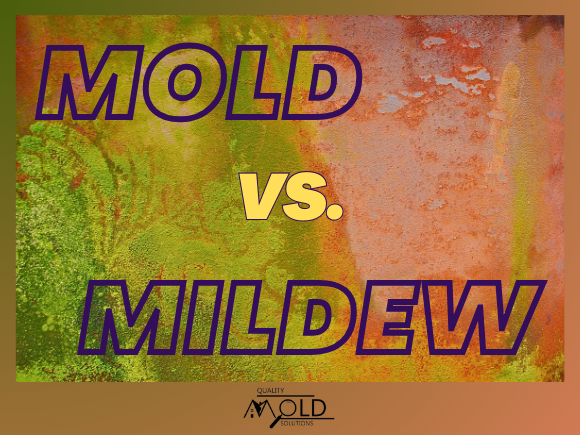If you’ve ever noticed an unsightly patch of growth on your walls, ceilings, or shower tiles, you may have asked yourself: is this mold or mildew? While both are types of fungi that thrive in moist environments, they have distinct characteristics, risks, and treatment methods. Knowing the difference between mold vs. mildew can help you address the problem effectively and protect your home and health.
What is Mildew?

Mildew is a surface-level fungus that appears as a flat, powdery or fluffy substance. It typically grows in warm, damp areas, such as bathrooms, kitchens, and basements. Mildew is often white, gray, or light yellow and can sometimes turn brown over time. Unlike mold, mildew doesn’t penetrate surfaces deeply, making it easier to clean and remove.
Common Places Where Mildew Grows:
- Shower walls and curtains
- Windowsills
- Basement floors
- Bathroom tiles
- Laundry rooms
Signs of Mildew:
- White, gray, or yellowish patches
- Musty, damp odor
- Easily wiped away with a cloth and cleaner
- Found on moist, non-porous surfaces
What is Mold?
Mold, on the other hand, is a more invasive and potentially hazardous type of fungus. It often appears fuzzy or slimy and can grow in a variety of colors, including black, green, blue, and red. Unlike mildew, mold can penetrate porous materials, such as drywall, wood, and insulation, making it more challenging to eliminate.
Common Places Where Mold Grows:
- Behind walls after water damage
- Under sinks and around plumbing leaks
- On ceilings due to roof leaks
- Inside HVAC systems
- On damp carpets and upholstery
Signs of Mold:
- Black, green, or dark-colored patches
- Musty, persistent odor
- Growth that spreads rapidly
- Can cause structural damage to surfaces
- Difficult to remove without professional help
Mold vs. Mildew: Key Differences
| Feature | Mildew | Mold |
|---|---|---|
| Appearance | Flat, powdery | Fuzzy, slimy |
| Color | White, gray, yellow | Black, green, blue, red |
| Smell | Mild, musty | Strong, musty, persistent |
| Growth Pattern | Surface-level | Deeply embedded |
| Health Risks | Minor allergies | Respiratory issues, serious health risks |
| Removal | Easy DIY cleaning | Often requires professional remediation |
When Should You Worry?
While mildew is usually a minor issue that can be addressed with household cleaners, mold is a more serious concern. Mold exposure can lead to a variety of health problems, including respiratory issues, allergies, and in some cases, severe illnesses. If you notice mold growth in your home, especially after water damage, it’s crucial to take action immediately.
When to Call a Professional:
- The mold covers a large area (more than 10 square feet)
- It keeps coming back after cleaning
- You experience persistent allergy symptoms or respiratory problems
- There is a strong, musty odor that won’t go away
- Mold is found in your HVAC system or deep within walls
The Way Out of the Mold vs. Mildew Dilemma: Prevention
Since both mold and mildew thrive in damp environments, keeping moisture levels under control is the best way to prevent their growth.
Tips to Keep Your Home Mold- and Mildew-Free:
- Use dehumidifiers in damp areas like basements
- Fix leaks in roofs, walls, and plumbing promptly
- Improve ventilation in bathrooms and kitchens
- Clean and dry water-damaged areas within 24-48 hours
- Regularly inspect your home for signs of moisture buildup


